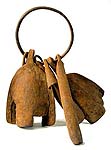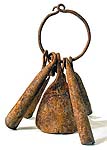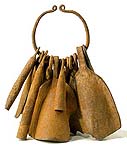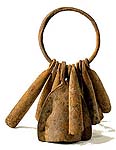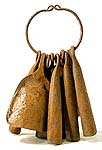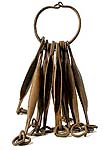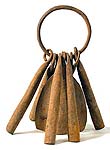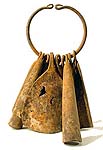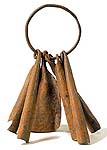CHAMBA (or YORUBA) GONG SET CURRENCY ARCHIVES, Nigeria
All of the gong sets below have been sold and are left here for
reference and educational purposes.
For unsold Chamba Gong Sets, please GO TO CHAMBA (OR YORUBA) GONG SET CURRENCY
Photographs © Hamill Gallery
CHAMBA, GONG SET CURRENCY, Nigeria
These iron forms functioned as gongs, but would also have been used
as currency (see below).
These can be hung on a wall or stand on their own, each time
taking a new configuration. The height in inches includes the ring, as pictured.
The number of gongs per set vary from 5.5 to 12.5, with .5 indicating a
very small or broken off remnant.
This collection of bells and 'clangers' are often identified as Yoruba, which they could be. This style or type of metal grouping is also reported as being from the Chamba people of the Benue River Valley. The Chamba seem to have a great variety of iron currency forms and may be the case that when forged iron currency is not specifically identified it is associated to the Chamba who live in a remote and very traditional region of Nigeria. The bell shaped forms and narrow 'clangers' are attached to a ring, keeping the individual pieces as part of a group that would have an enhanced value due to the material and their forms. Equally, each element could be exchanged separately for goods. Forged iron currency has a long history throughout west Africa dating back to the first millennium from evidence of iron working in northern Nigeria. The convertibility of forged iron into other objects makes it an ideal form of currency. Equally, in the shape of bells and clangers it could equally serve as a musical and ritual object.
Dr. Daniel Mato
Professor Emeritus of Art History
The University of Calgary
Calgary, Alberta, Canada
GO TO SIDE
BY SIDE EXHIBITION PAGE
GO TO YORUBA CURRENCY PAGE
GO TO AFRICAN CURRENCY EXHIBITION
PAGE
GO TO AFRICAN CURRENCIES PAGE
GO TO AFRICAN METALWORK PAGE
GO TO AFRICAN
METALWORKS EXHIBITION PAGE
GO
TO AFRICAN METALWORKS EXHIBITION PAGE 2
